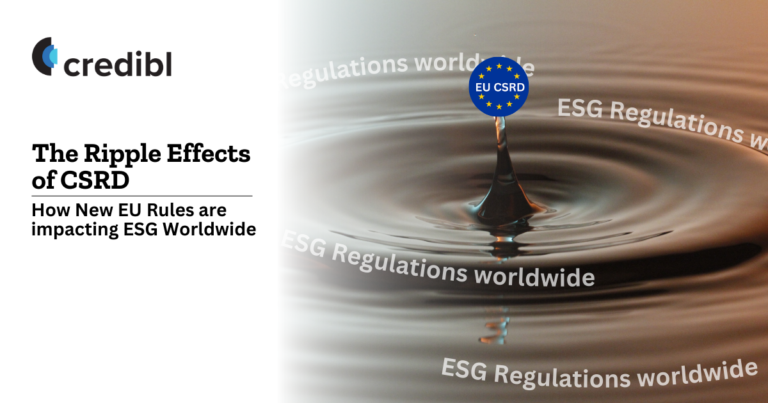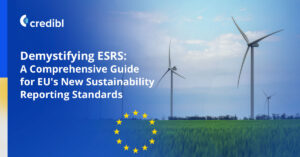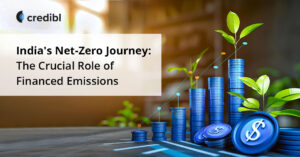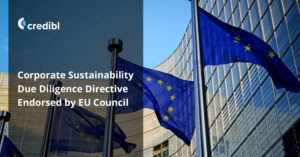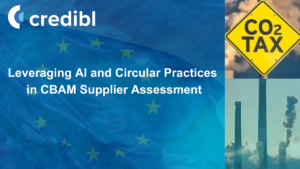Remember the ripple effect? Imagine tossing a pebble into a pond – ripples spread outwards, eventually fading into the distance. Now picture a tidal wave. The force doesn’t just create ripples, it reshapes the entire landscape. That’s the potential impact of the EU’s Corporate Sustainability Reporting Directive (CSRD) on global ESG progress.
Beyond Borders: The Ripple Effect Goes Global
While the CSRD directly targets EU companies, its influence doesn’t stop at geographical boundaries. Here’s why:
- Domino Effect on Regulations: Don’t underestimate the “copycat effect.” Countries like Indonesia and Brazil are revising their sustainability reporting rules, explicitly citing the CSRD as inspiration. This creates a global momentum for stricter ESG standards, even for non-EU players. A recent survey by EY in 2023 found that over 60% of companies in Asia Pacific are planning to enhance their ESG reporting due to the influence of the CSRD.
- Supply Chain Squeeze: Think dominoes falling on your suppliers. EU companies, now subject to stricter reporting, will demand more ESG data from their suppliers, regardless of location. This pushes even non-EU players to adopt better practices to stay competitive. A recent McKinsey study found that 70% of global supply chain emissions originate from upstream activities, highlighting the domino effect in action. According to a 2023 report by Gartner, 75% of supply chain leaders are expecting increased pressure from their customers to improve their ESG performance due to the CSRD.
- Investor Spotlight: The EU’s transparency push shines a global spotlight. Investors worldwide are paying attention, with 80% of asset owners globally now integrating ESG considerations into their investment decisions, according to the Global Sustainable Investment Alliance (GSIA) in 2023. Companies globally face increased pressure to demonstrate genuine ESG commitment to attract capital. BlackRock, the world’s largest asset manager, explicitly stated that companies failing to address sustainability risks face losing access to capital.
From Reporting to Progress: More Than Just a Compliance Exercise
But CSRD isn’t just about checking boxes. It holds the potential to:
- Drive Innovation: Remember the pebble, not the wave. Companies scrambling to meet ESG goals will spur eco-friendly solutions and technologies. Think green materials, renewable energy, and circular economy models. The Ellen MacArthur Foundation estimates that the circular economy could generate $1 trillion in annual economic benefits by 2030. A recent study by Accenture found that companies that have embraced circular economy principles have witnessed a 5-10% increase in revenue.
- Unlock Hidden Value: Sustainability isn’t just about “doing good,” but also “doing well.” Embracing ESG often leads to cost savings, improved efficiency, and enhanced brand reputation. A study by NYU Stern in 2022 found that companies with strong ESG performance outperform their peers by 3-5% per year. A 2023 McKinsey report revealed that over 60% of executives believe that strong ESG performance can lead to a financial advantage.
- Empower Stakeholders: Transparent reporting fosters trust and accountability, ensuring stakeholders’ voices are heard and addressed. This creates a more inclusive and sustainable business ecosystem. A recent Edelman survey revealed that 78% of global consumers would choose, switch, or boycott brands based on their social and environmental impact.
Riding the Wave: Practical Steps for a Sustainable Future
So, how can you navigate this evolving landscape? Don’t get caught in the undertow:
- Get Ahead of the Curve: Don’t wait for regulations to hit. Start integrating ESG principles into your operations now. A recent EY survey found that only 43% of companies say they’re prepared for the CSRD, highlighting the need for proactive action. According to a 2023 PwC report, over 70% of businesses believe that they are not fully prepared to meet the CSRD requirements.
- Engage Stakeholders: Understand their ESG expectations and proactively address them. Transparency is key. A recent PwC study found that 73% of investors consider stakeholder engagement a critical factor in ESG assessment.
- Embrace Technology: Utilize data management tools and platforms to streamline reporting and gain valuable insights. Look for solutions like Ecova, Arabesque S-Ray, or Sustainalytics to navigate the data deluge.
- Seek Guidance: Collaborate with experts and join industry initiatives to stay informed and navigate the complexities. The Global Reporting Initiative (GRI) and the Sustainability Accounting Standards Board (SASB) offer valuable resources and frameworks. Additionally, with the recent creation of the International Sustainability Standards Board (ISSB) in 2021, there is a push for standardization of sustainability reporting, making it easier for companies to compare and benchmark their performance.
Leading the Charge: Real-World ESG Champions
The CSRD may be fresh on the scene, but companies worldwide are already demonstrating the power of proactive ESG integration. Here are just a few examples:
- Unilever: This consumer goods giant set ambitious goals to halve its environmental footprint and improve the livelihoods of millions in its supply chain, achieving carbon neutrality across its European operations in 2020.
- Ørsted: This Danish energy company transitioned from fossil fuels to become the world’s largest offshore wind developer, showcasing the potential for clean energy innovation.
- Patagonia: This outdoor apparel brand is a vocal advocate for environmental protection, integrating sustainability into its core business model and activism efforts.
- Nestlé: This global food and beverage giant has committed to a series of ambitious sustainability goals, including achieving net-zero emissions by 2050 and sourcing 100% of its key commodities responsibly by 2025. A recent study found that Nestlé’s efforts in reducing its greenhouse gas emissions have resulted in significant cost savings for the company.
These are just a glimpse into the diverse landscape of ESG leadership. A recent study by Arabesque S-Ray found that companies with strong ESG performance outperformed their peers by 4.3% in stock returns over the past five years, highlighting the financial benefits alongside the environmental and social impact.
Data Dive: Quantifying the CSRD’s Impact
The CSRD’s reach extends far beyond the EU’s borders. Here’s a snapshot of its global influence:
- Market Impact: Over 50,000 companies globally will be subject to mandatory sustainability reporting under the CSRD’s wider scope, representing a market worth an estimated €80 billion, according to Bloomberg Intelligence.
- Investor Influence: Assets under management focused on ESG strategies reached a record $41.6 trillion globally in 2022, representing 43% of total professionally managed assets, according to the Global Sustainable Investment Alliance (GSIA).
- Supply Chain Transformation: A recent CDP report revealed that 87% of global companies by revenue are now setting emissions reduction targets, driven in part by pressure from their EU-based customers complying with the CSRD.
These figures paint a clear picture: the CSRD is a game-changer, not just for the EU, but for the global ESG landscape.
Conclusion: The Future is Sustainable
The CSRD is a powerful force for change, but it’s not the only wave washing over the global business landscape. Consumer demand for sustainable products and services is rising, with 73% of global consumers willing to pay a premium for sustainable brands according to Nielsen. Investors are increasingly prioritizing ESG factors, and regulators worldwide are tightening sustainability standards.
The future is undoubtedly sustainable. By understanding the CSRD’s global impact, embracing its potential, and utilizing available resources, companies can become proactive players in shaping a more sustainable future. It’s time to ride the wave, not get caught in the undertow. Are you ready?


